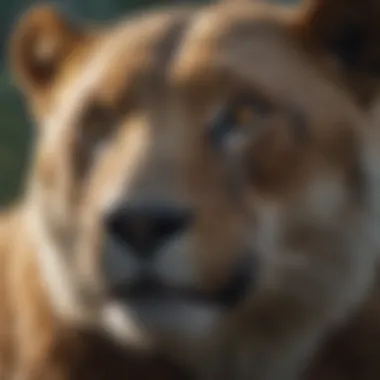The Importance of Wildlife Conservation for Our Future


Intro
Wildlife conservation plays a pivotal role in maintaining the delicate balance of our ecosystems. Its importance transcends mere affection for animals, encompassing vital elements of our environmental, economic, and ethical frameworks. This article will explore the reasons wildlife conservation matters, addressing the multifaceted benefits it brings to our world. Those who engage in conservation efforts not only safeguard diverse species but also enhance the overall health of the planet.
Background and Context
Overview of the research topic
Wildlife conservation is an expansive field that integrates various disciplines. It includes biology, ecology, geography, and sociology, among others. The primary goal is to preserve species from extinction. Conservation efforts focus on protecting habitats, managing natural resources, and promoting coexistence between humans and wildlife. According to the International Union for Conservation of Nature (IUCN), one million species are currently at risk of extinction due to human activities like habitat destruction, pollution, and climate change.
Historical significance
The roots of wildlife conservation can be traced back to the early 20th century, when awareness about dwindling animal populations began to rise. The establishment of the first national parks, such as Yellowstone in 1872, marked a turning point. Laws were introduced to regulate hunting and promote habitat protection. Over the decades, notable efforts like the Endangered Species Act in the United States have set legal precedents aimed at curbing loss of biodiversity. The historical context underscores the ongoing struggles faced in the battle for conservation.
Key Findings and Discussion
Major results of the study
Recent studies demonstrate that effective wildlife conservation has tangible benefits for ecological stability and human welfare. The preservation of habitats leads to healthier ecosystems that provide essential services, such as clean air and water. For instance, preserving wetlands can mitigate flood risks, while intact forests contribute to carbon sequestration. Moreover, diverse ecosystems enhance agricultural productivity by supporting pollinator populations.
Detailed analysis of findings
Research shows that successful conservation strategies often involve community engagement. Programs that include local populations in decision-making and management processes yield better results. Understanding local cultures and respecting indigenous knowledge are key elements in implementing effective conservation practices. The interconnectedness of species means that the loss of one can have cascading effects on others, illustrating the urgency of action in this domain.
"Conservation is a state of harmony between men and land."
- Aldo Leopold
We must recognize the role that wildlife conservation plays in global economies as well. The economic value of biodiversity is immense, impacting tourism, agriculture, and even medicine. Many communities thrive on ecotourism, relying on healthy ecosystems to attract visitors. Thus, investing in wildlife conservation is not just an ethical obligation; it is also an economic necessity for sustaining livelihoods.
Prolusion to Wildlife Conservation
Wildlife conservation plays a vital role in protecting nature’s diverse species and maintaining ecological balance. As human activities increasingly threaten various wildlife species and their habitats, the need for effective conservation measures becomes more urgent. This section will explore the definition and scope of wildlife conservation, along with its historical context, providing insight into its significance in promoting environmental sustainability.
Definition and Scope
Wildlife conservation refers to the practices and strategies aimed at safeguarding the natural environment and preserving biodiversity. It encompasses various efforts to protect endangered species, restore habitats, and promote sustainable use of natural resources. This scope includes a wide range of initiatives, such as creating protected areas, engaging local communities, and enforcing laws against illegal wildlife trade.
The ultimate goal of wildlife conservation is to ensure that ecosystems remain healthy and functioning. This is important not just for wildlife but also for human beings, as healthy ecosystems provide essential services such as clean air, water, and fertile soil. Thus, conservation efforts have far-reaching impacts, affecting both our planet and our quality of life.
Historical Context
The concept of wildlife conservation is not new; it has roots that date back centuries. Early civilizations often recognized the importance of preserving certain species and their habitats. However, it was not until the 19th and 20th centuries that conservation became more organized and focused.
During the late 19th century, the industrial revolution in Europe and North America led to significant habitat destruction and species extinction. In response, conservationists began advocating for laws to protect wildlife. One notable example is the establishment of Yellowstone National Park in 1872, the first national park in the world, setting a precedence for future conservation efforts.
The formation of the International Union for Conservation of Nature (IUCN) in 1948 marked a significant milestone in global conservation effort. This organization continues to play a crucial role in coordinating worldwide activities aimed at preserving wildlife and their habitats. Currently, numerous agreements and treaties, such as the Convention on Biological Diversity, shape how countries approach wildlife conservation.
In recent years, increasing awareness about climate change and biodiversity loss has further emphasized the need for comprehensive conservation tactics. This evolution in understanding indicates an acknowledgment that wildlife conservation is not only about protecting species but also involves addressing broader environmental issues.
"Nature is not a place to visit. It is home."
- Gary Snyder
Through this historical lens, it is clear that wildlife conservation has progressed from a localized effort to a global imperative, reflecting the interconnectedness of all living organisms and the ecosystems they inhabit.
Ecological Importance of Wildlife
Wildlife plays a critical role in the health of ecosystems. Various species interact with each other and their environments in complex ways, contributing to the balance of nature. The loss of any species can lead to significant repercussions, disrupting these systems. The importance of wildlife cannot be overstated, as it has profound effects on biodiversity, ecological services, and overall ecosystem resilience.
Biodiversity and Ecosystem Services
Biodiversity is fundamental to sustaining the earth's ecosystems. It refers to the variety of life, from genes to species to ecosystems. Higher biodiversity typically leads to more resilient ecosystems capable of withstanding environmental changes.
Wildlife supports ecosystem services that are essential to human survival and well-being:
- Pollination: Many plants rely on animals, such as bees and birds, for pollination. This process is vital for the reproduction of over 75% of flowering plants that produce fruits and vegetables.
- Nutrient Cycling: Various species contribute to the breakdown and recycling of organic matter. For example, decomposers like fungi and insects break down dead organisms, returning nutrients to the soil.
- Water Purification: Wetlands and aquatic ecosystems filter pollutants, providing clean water for human use and maintaining the health of aquatic life.
In essence, wildlife supports numerous ecosystem services that uphold the planet's health and directly affect human livelihoods.
Predator-Prey Dynamics
The relationship between predators and prey is vital to maintaining ecological balance. Predators control the population of prey species, preventing overpopulation and depletion of resources. This dynamic is a cornerstone of ecosystem health.
For instance, the presence of wolves in a region can regulate deer populations. Without predators, prey might proliferate unchecked, leading to overgrazing, which in turn damages plant communities and disrupts habitats. This interdependency exemplifies why conserving wildlife is crucial for maintaining ecosystem integrity.
Habitat Preservation


Suitable habitat is essential for the survival of wildlife species. Conservation efforts that focus on habitat preservation can help sustain biodiversity. Loss of habitat due to urbanization, deforestation, and agriculture threatens many species globally.
To protect wildlife, several approaches can be employed:
- Establishing Protected Areas: National parks and wildlife reserves preserve crucial habitats and create safe havens for species.
- Restoration Projects: These initiatives aim to restore degraded habitats, bringing back the native flora and fauna.
- Sustainable Practices: Integrating wildlife considerations in agricultural and urban planning is vital for coexistence.
Maintaining diverse habitats ensures that global biodiversity remains intact, enabling all species, including humans, to thrive.
Economic Benefits
The economic benefits of wildlife conservation encompass several aspects that contribute significantly to local and global economies. These benefits extend from direct financial gains through tourism to the broader implications of ecosystem services. Understanding these elements is crucial for promoting conservation efforts as viable economic strategies.
Sustainable Tourism
Sustainable tourism is one of the most prominent ways in which wildlife conservation yields economic benefits. This form of tourism emphasizes responsible travel to natural areas, aiming to conserve the environment and improve the well-being of local people. Unlike conventional tourism that may exploit natural resources, sustainable tourism strives for balance.
Visitors are often willing to pay premium prices for experiences that involve wildlife observation, such as safaris in Kenya or bird-watching tours in Costa Rica. These activities generate revenue that can be invested back into conservation initiatives. Additionally, they create jobs for local communities, thus reducing poverty and fostering a sense of stewardship toward local wildlife.
Restaurants, hotels, and transport services in these areas also benefit from increased foot traffic. Therefore, protecting wildlife not only secures animal populations but also ensures economic stability for communities that rely on nature-based tourism.
Ecosystem-Based Economic Advantages
Ecosystem-based economic advantages stem from the various services provided by healthy ecosystems. These services include clean water, pollination of crops, carbon storage, and soil fertility. Such benefits are not always immediately visible but are vital for long-term economic sustainability.
For instance, wetlands support biodiversity and provide flood protection while also filtering water. These ecosystems can reduce the costs associated with water treatment and disaster management. Investing in the conservation of ecosystems leads to long-term savings and benefits that far exceed the initial costs.
Protecting ecosystems is not just an act of compassion but an intelligent economic strategy that yields returns for generations to come.
By recognizing the value of ecosystem services, policymakers can create incentives that promote conservation. This can lead to developments in agriculture, forestry, and fisheries, where sustainable practices enhance productivity while maintaining the ecological balance.
In summary, the economic benefits of wildlife conservation, especially through sustainable tourism and ecosystem services, highlight the fundamental link between environmental health and economic prosperity. The investment in wildlife protection and habitat conservation serves not just to save animals but also to drive local and global economies into a sustainable future.
Cultural Significance
Cultural significance of wildlife conservation reveals how human societies view, respect, and interact with nature. It forms the bedrock of various traditions, practices, and ethical considerations. Understanding this significance enriches the discourse around wildlife conservation, highlighting its interconnectedness with societal values and norms.
Wildlife in Cultural Practices
Throughout history, wildlife has held a prominent place in cultural practices across the globe. Many indigenous communities possess a deep-rooted connection to the animals and ecosystems around them. For instance, the Maasai in East Africa view lions as symbols of bravery and strength. This perspective fosters a relationship of respect rather than hostility towards predators, redefining the narrative around wildlife encounters.
In addition to traditions, wildlife also features heavily in art, storytelling, and rituals. In numerous cultures, animals represent characteristics or themes. For example, the eagle is often associated with freedom in Native American culture. Such relationships help reinforce the idea that the conservation of wildlife extends beyond biological imperatives; it is also a matter of cultural survival.
Furthermore, promoting conservation through cultural practices can enhance community engagement. By organizing events that celebrate local wildlife, communities can foster awareness and appreciation of their natural heritage. In engaging local customs and lore, conservation efforts can align with existing values to create more meaningful connections for the community.
Symbolism and Identity
Wildlife often represents aspects of human identity. For many, specific animals are symbols of national pride or cultural identity. For example, the bald eagle is not just a bird; it serves as a national emblem of the United States. This symbolism enhances the emotional connection people feel towards wildlife, driving the impulse to protect these animals and their habitats.
Moreover, the decline of a species can lead to a loss of symbolic meaning. For communities who identify closely with certain animals, extinction can cause profound cultural loss. The loss of biodiversity is not merely an ecological concern; it resonates on a personal level, tying into a community's history and future. Thus, wildlife conservation becomes a means of preserving cultural identity.
"Protecting wildlife is tantamount to safeguarding the stories and identities that are interwoven with our natural world."
The interplay between wildlife and cultural significance is vital in understanding the broader implications of conservation efforts. It illustrates that preserving wildlife goes beyond ecological or economic reasoning; it is an ethical imperative to safeguard the rich tapestry of human culture. By integrating cultural significance into conservation strategies, initiatives can become more relevant and impactful, fostering a more profound connection between communities and their natural environments.
Ethical Considerations
Wildlife conservation is closely tied to a range of ethical considerations. These considerations play a vital role in shaping the philosophy behind conservation efforts. Understanding what is at stake is essential for fostering a genuine commitment to protecting Earth's species.
Moral Responsibility
The moral responsibility to protect wildlife lies at the heart of conservation ethics. Humans have the capacity to alter ecosystems substantially, leading to adverse effects on various species. This manipulation raises the question of our duty towards other living beings.
By considering our role as stewards of the environment, we acknowledge that every species holds intrinsic value. The extinction of any one species disrupts ecological balance and can have repercussions for other living organisms, including humans. Moreover, our existence itself relies on healthy ecosystems that provide clean air, water, and food. As such, it is our ethical obligation to mitigate harm and serve as protectors rather than destroyers of the natural world.
Further, as we consume vast resources and expand our infrastructures, we encroach upon habitats. This assertion of power over nature is often seen as neglecting our ethical duties. Failing to recognize and act upon this moral responsibility could lead to more profound biodiversity loss. Thus, the need to adopt responsible conservation measures is critical for maintaining ecological integrity.
"The ethical obligations of humanity extend towards all living beings, urging us to act with consideration and respect."
Species Extinction and Its Impact
The topic of species extinction is not merely a scientific concern; it poses significant ethical dilemmas. The loss of species impacts more than just the animals themselves. It reshapes entire ecosystems and jeopardizes the web of life that supports us all. Ethical considerations urge us to analyze the consequences of extinction on both ecological and human levels.
When a species disappears, we lose valuable genetic diversity, which is crucial for adaptive responses to changing environments. This loss can lead to increased vulnerability for many species, including those that rely on the extinct species for survival. For example, if a pollinator like a bee species goes extinct, the plants they fertilize also decline. This phenomenon creates a ripple effect, ultimately leading to food shortages and habitat destabilization.
Additionally, the act of extinction can have profound cultural ramifications. Many species are embedded in local cultures, symbolizing history and identity. The extinction of these species not only eliminates biological diversity but also dims cultural narratives that have existed for generations.
Thus, addressing species extinction encompasses moral responsibilities as well. It requires informed action, proactive policies, and a commitment to ethical stewardship. Conservation measures should anticipate these diverse impacts and seek to preserve not just wildlife but the intricate relationships that sustain humanity and nature alike.


Threats to Wildlife
Understanding the threats to wildlife is a critical component of recognizing the need for conservation efforts. These threats not only jeopardize the survival of numerous species but also disrupt ecological balance. By pinpointing the specific elements fronting wildlife today, we can better address and prioritize conservation strategies.
Habitat Destruction
Habitat destruction is perhaps the most pressing threat facing wildlife today. This phenomenon often results from human activities such as logging, urban development, and agriculture. When natural habitats are altered or eliminated, animals lose their homes, sources of food, and breeding grounds. The fragmentation of habitats can lead to isolated populations that struggle to survive. Moreover, habitat destruction has profound consequences for biodiversity. For instance, species that rely on particular habitats, like forests or wetlands, may find themselves on the brink of extinction.
The importance of preserving habitats is highlighted by the fact that about 1 million species are currently at risk of extinction, many due to habitat loss. Keeping ecosystems intact not only supports wildlife but also aids human survival, as we depend on diverse ecosystems for clean air, water, and food.
Climate Change
Climate change presents a significant challenge to wildlife conservation. As global temperatures rise, many species struggle to adapt to changing weather patterns and food availability. For example, polar bears rely on sea ice to hunt seals. As the ice melts due to warmer temperatures, their hunting grounds diminish. This leads to declining populations and threatens the overall balance of Arctic ecosystems.
The effects of climate change are not limited to specific species. Ecosystems as a whole experience shifts that can create mismatches in the timing of food availability and breeding cycles. Keystone species, which play a crucial role in maintaining the structure of an ecosystem, may also be affected, leading to cascading impacts throughout the food chain. Organizations are working on mitigating climate change effects through habitat restoration and sustainable practices that lower carbon emissions.
Pollution
Pollution poses an invisible yet substantial threat to wildlife. Chemicals from industrial waste, agricultural runoff, and plastics infiltrate natural environments, leading to dire consequences for wildlife health. Toxins can accumulate in the food chain, affecting not just individual species but entire ecosystems. For instance, birds of prey have been severely impacted by heavy metals and pesticides that accumulate in their bodies, leading to reproductive failure and mortality.
Water pollution also endangers aquatic species. Many fish rely on clean waterways, and the introduction of contaminants can lead to loss of biodiversity and altered community structure. Overall, reducing pollution is vital not only for wildlife but also for maintaining human health and safety.
Illegal Wildlife Trade
Illegal wildlife trade is a critical and often overlooked threat. This black market operates in secrecy, targeting endangered species for profit. Elephants are hunted for their ivory, while rhinos are poached for their horns. The consequences are devastating—not just for the species involved, but also for entire ecosystems. The removal of key species disrupts the natural balance and can lead to overpopulation of certain species, causing ecological strain.
Combating illegal wildlife trade requires concerted efforts at international levels. Advocacy and legislative changes are essential to bring about real change. Additionally, raising awareness about the impact of this trade can help reduce demand for illegal wildlife products. Organizations and governments are increasingly working together to create more robust protections for endangered species, aiming to curb this illegal market.
"The extinction of a species represents a permanent loss, a fracture in the biodiversity that sustains ecosystems and, ultimately, human life."
By highlighting these threats, we can emphasize the need for a collective response to wildlife conservation. Without addressing these issues head-on, we risk further endangering species and compromising ecological integrity.
Conservation Strategies
Conservation strategies play a crucial role in safeguarding the delicate balance of ecosystems and species around the globe. Such strategies are essential not only for the protection of wildlife but also for maintaining the integrity of our natural environments. The importance of conservation strategies lies in their ability to provide structured approaches to address the various challenges facing wildlife today. This section will delve into three significant strategies: protected areas and reserves, community-led initiatives, and legislation and policy changes.
Protected Areas and Reserves
Protected areas and reserves are designated spaces intended to conserve wildlife and their habitats. These areas can range from national parks like Yellowstone in the United States to wildlife sanctuaries across Africa such as the Masai Mara. The primary objective is to minimize human interference, allowing ecosystems to function effectively.
The benefits of such zones are numerous:
- Biodiversity Preservation: These areas help in preserving various species, especially those that are endangered or threatened.
- Ecosystem Services: Protected areas offer essential services such as water purification and soil stabilization, which are vital for human survival.
- Educational Opportunities: They can serve as living laboratories where students and researchers can study ecosystems in a controlled environment.
However, establishing and maintaining these areas can pose challenges. Issues include funding, political will, and sometimes local communities that depend on these lands for their livelihoods may resist conservation efforts.
Community-Led Initiatives
Community-led initiatives involve local populations in the decision-making and implementation of conservation efforts. Such strategies recognize that sustainable conservation often flows from the engagement and cooperation of individuals who live in proximity to wildlife habitat.
This approach offers several advantages:
- Local Knowledge: Communities possess valuable knowledge about their ecosystems. Engaging them improves the effectiveness of conservation efforts.
- Shared Responsibility: When locals are involved, they often feel a sense of ownership towards conservation projects, which can enhance commitment and success rates.
- Alternative Livelihoods: Initiatives often include developing alternative means of income that do not harm local wildlife, such as ecotourism.
Nevertheless, for these initiatives to thrive, transparency and equitable resource distribution among community members are paramount. Without such measures, inequality can lead to potential conflicts.
Legislation and Policy Changes
Legislation and policy changes are fundamental for establishing a framework for wildlife protection. Laws often dictate how resources are managed and protected, thus influencing conservation outcomes directly. Significant international treaties such as the Convention on Biological Diversity emphasize the need for unified efforts in conservation.
Key aspects of this strategy include:
- Regulatory Measures: Enforcing laws against poaching and habitat destruction can significantly contribute to population recovery among at-risk species.
- Funding Support: Governments and organizations can allocate resources specifically for conservation efforts through policy measures.
In summary, successful conservation strategies require a multifaceted approach. Integrating protected areas, community participation, and effective legislation can create a robust framework for preserving wildlife and their environments.
"The conservation of wildlife is a global concern, requiring cooperation and commitment at every level of society."
This comprehensive approach not only addresses immediate threats to wildlife but also fosters an environment conducive for addressing future challenges.
Global Perspectives on Wildlife Conservation
Global perspectives on wildlife conservation provide a framework for understanding the various factors that influence approaches to protecting biodiversity across different regions. The need to safeguard wildlife is universal, yet the strategies and practices adopted can vastly vary, shaped by cultural, economic, and political contexts. By examining these global perspectives, we can identify not only the common challenges faced but also the innovative solutions that different regions implement to address wildlife preservation.
International Treaties and Agreements
These agreements facilitate cooperation among countries and emphasize the need for accountability and transparency in wildlife management. For instance, through CITES, countries commit to monitoring and controlling the trade of over 35,000 species, thus reducing the risk of exploitation. This international cooperation is essential in addressing wildlife trafficking, which remains a significant threat to many species.


Moreover, the success of these treaties depends not only on governmental adherence but also on ongoing engagement with various stakeholders, including local communities, indigenous groups, and NGOs. Ensuring that these agreements translate into effective action on the ground requires continuous dialogue and collaboration among all parties involved.
Regional Differences in Conservation Efforts
Conservation efforts often depend on regional contexts, influenced by varying economic conditions, cultural values, and environmental challenges. For example, in Africa, community-based conservation programs, such as those implemented in Namibia, have proven successful. These initiatives empower local populations by involving them in wildlife management, thus fostering a sense of stewardship over natural resources.
In contrast, Western countries may focus more on establishing protected areas and national parks. The Yellowstone National Park in the United States serves as an example where conservation strategies emphasize habitat preservation through strict regulations against poaching and habitat destruction.
Similarly, the Amazon rainforest conservation efforts hinge on balancing environmental protection with the needs of local populations. Various NGOs work together with local communities to develop sustainable land-use practices that minimize deforestation while allowing for economic development.
Despite these regional differences, the common thread lies in recognizing that biodiversity loss and its consequences do not respect national borders. Therefore, collaboration across regions is pertinent in creating effective wildlife protection strategies.
"Protecting wildlife requires a global effort that transcends boundaries; it is not just a responsibility of one nation but a collective duty."
Ultimately, understanding the complex dynamics of global perspectives on wildlife conservation is crucial for developing adaptable strategies that meet the needs of local ecosystems while reinforcing our commitment to protecting biodiversity on a larger scale.
Role of Technology in Conservation
Technology plays an essential role in wildlife conservation, revolutionizing the way we monitor ecosystems and protect species. The integration of advanced tools and techniques into conservation strategies allows for more precise data collection and analysis, which is crucial in an era where biodiversity is under constant threat. Utilizing technology not only enhances our current understanding of wildlife patterns but also shapes effective interventions for environmental protection. As conservation becomes increasingly complex, the role of technology becomes pivotal in addressing challenges and fostering sustainability.
Remote Sensing and Monitoring
Remote sensing technology has transformed the field of wildlife conservation. This technology involves using satellites, drones, and other aerial devices to collect data on ecosystems and wildlife populations. One of the primary benefits of remote sensing is the ability to cover vast and inaccessible areas efficiently.
Remote sensing provides crucial information on habitat conditions, deforestation rates, and changes in land use. For example, sensors on satellites offer imagery that reflects vegetation health, which helps in understanding habitat availability for various species. By analyzing this information, conservationists can identify critical habitats and make informed decisions about conservation efforts.
Furthermore, monitoring wildlife movements through remote sensing allows researchers to track migration patterns and habitat utilization, leading to valuable insights into how species respond to environmental changes.
However, this technology also raises considerations regarding data interpretation. Accurate data analysis is essential, as misinterpretations can lead to ineffective conservation strategies. To mitigate these concerns, collaboration between technology experts and field biologists is necessary. This combined effort ensures that the data accurately reflects the realities on the ground.
Data Analytics for Biodiversity
Data analytics has emerged as a powerful tool in wildlife conservation. By utilizing large sets of ecological data, researchers can identify trends and patterns that were previously difficult to discern. This involves processing and analyzing data collected from various sources, including remote sensing, field surveys, and citizen science initiatives.
The benefits of incorporating data analytics are significant:
- Enhanced Decision-Making: Data analysis enables conservationists to make evidence-based decisions, focusing resources where they are most needed.
- Predictive Modeling: Analytical models can predict the future impacts of climate change, habitat loss, and human activity on diverse species. This foresight is crucial for proactive conservation planning.
- Monitoring Effectiveness: By assessing the outcomes of conservation programs through data analytics, stakeholders can continuously improve their strategies.
An example of effective data analytics in conservation is the use of machine learning. This technology can analyze soundscape data to identify species vocalizations, providing insights into species presence and abundance without invasive methods.
"The integration of technology and data analytics in wildlife conservation is not merely an enhancement of existing methodologies; it constitutes a fundamental shift towards a more informed and strategic approach."
Future of Wildlife Conservation
The future of wildlife conservation plays a crucial role in understanding how we interact with our planet and the diverse species inhabiting it. In an age marked by rapid environmental changes, humanity faces a pivotal moment. The decisions made today regarding wildlife conservation can have cascading effects on future generations. Insufficient action may lead to irreversible consequences that threaten the delicate balance of ecosystems. Hence, it is essential to delve into the emerging trends, challenges, and the overarching role of education in shaping a sustainable future for wildlife.
Emerging Trends and Challenges
Conservation efforts are evolving. Several innovative approaches are gaining traction in response to both traditional and modern challenges.
- Technological Integration: The use of technology such as drones and camera traps is becoming more widespread. These advancements allow for more effective monitoring of wildlife populations and habitats.
- Community Involvement: Local communities are now taking active roles in conservation efforts. This trend acknowledges the importance of indigenous knowledge and participation, leading to more culturally sensitive and sustainable practices.
However, challenges remain formidable. Increasing threats from urban expansion and climate change test our ability to preserve biodiversity. Specifically:
- Habitat Loss: As urban areas expand, natural habitats are often destroyed or fragmented, creating barriers for wildlife.
- Climate Change Effects: Changes in temperature and weather patterns can drastically alter habitats, making them uninhabitable for certain species.
- Funding Limitations: Financial resources for conservation initiatives often fall short, leading to gaps in necessary actions.
Addressing these trends and overcoming challenges requires a multifaceted approach that brings together stakeholders from various sectors.
The Role of Education
Education is an essential pillar of wildlife conservation's future. Understanding the importance of ecosystems and the species within them empowers individuals to take action.
- Awareness Programs: Schools and community groups can implement programs that highlight local wildlife conservation issues. Such initiatives can foster a sense of responsibility among the younger generation.
- Higher Education Research: Universities play a vital role in advancing conservation science. Research conducted on biodiversity, climate adaptation strategies, and legal frameworks contributes significantly to knowledge in this field.
- Public Policy Education: Educating policymakers about the implications of their decisions on wildlife conservation can lead to more informed legislation.
"Education is the most powerful weapon which you can use to change the world." – Nelson Mandela
The End
Furthermore, the economic benefits derived from healthy wildlife populations and thriving ecosystems cannot be overstated. Sustainable tourism generates revenue while promoting conservation awareness. This is particularly vital for local communities that depend on natural resources. The discussion around the cultural significance of wildlife also presents compelling arguments for conservation. As symbols of national identity or components of indigenous practices, wildlife enrich our cultural landscapes.
Recapitulation of Key Points
- Ecological Balance: Protecting wildlife is essential for maintaining biodiversity, which is critical for healthy ecosystems.
- Economic Advantages: Wildlife conservation supports sustainable tourism and offers various ecosystem services that benefit economies.
- Cultural Connections: Many cultures regard wildlife as an integral part of their traditions and identities, highlighting the need for their protection.
- Ethical Responsibility: There exists a moral duty to prevent species extinction and the associated impacts on biodiversity.
In light of these points, we now turn to how we can translate understanding into action.
Call to Action
It is imperative for individuals, communities, and governments to take concerted steps towards wildlife conservation. Here are several practical actions that can be implemented:
- Support Conservation Organizations: Engaging with or donating to organizations like World Wildlife Fund (WWF) or Conservation International can directly contribute to vital habitat protection efforts.
- Educate Others: Raising awareness about the importance of wildlife can inspire more people to participate in conservation activities.
- Advocate for Stronger Policies: Engage in local political processes to advocate for laws that protect wildlife and their habitats. This includes supporting legislative measures that prevent pollution and habitat destruction.
- Sustainable Practices: Embrace and encourage sustainable consumer practices that minimize impact on natural environments. Choose products that are certified as sustainable, and promote local, eco-friendly options.
Wildlife conservation is a shared responsibility that calls for immediate action. It is time for us to commit to preserving biodiversity for the well-being of our planet and future generations.







